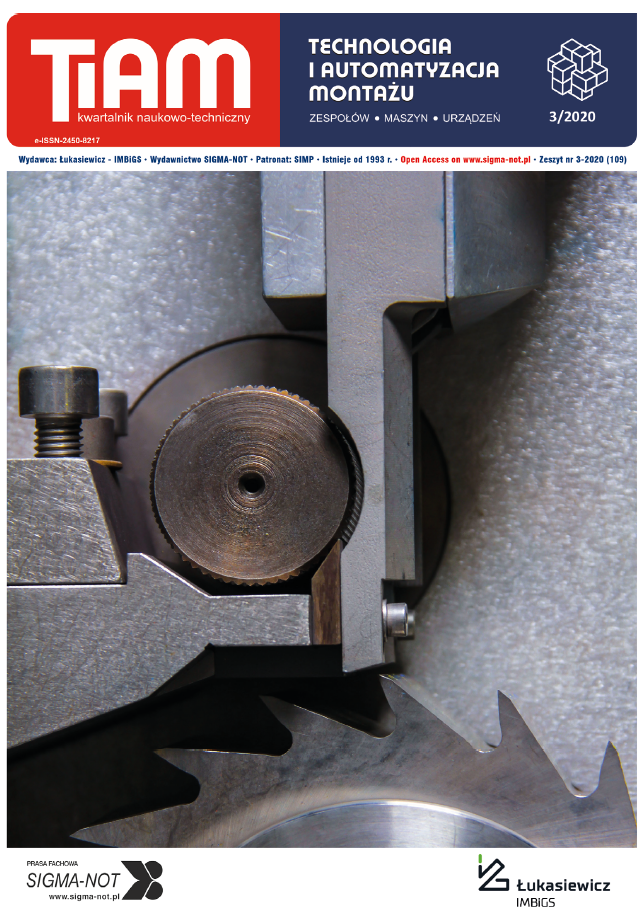Abstract
This paper presents the results of numerical calculations to compare the stress fields of hybrid (mechanicaladhesive) joints. ANSYS ver.19 was used as a computing tool with its solver based on finite element method (FEA – Finite Element Analysis). Based on the results obtained, a comparative analysis of the stresses in the adhesive joints for adhesives with different Young's modulus including different mounting schemes of mechanical fasteners and pressures caused by the assembly of the mechanical fasteners was performed. For modelling purposes of hybrid joints it is assumed that calculations will be made for single-lap joints where specimens with AW 2024T3 material parameters were joined. The adhesive layer was modelled by two layers of elements, adding i.a. pressure to the adherend caused by a preliminary tension of mechanical fasteners. In order to reduce the negative peeling effect at the ends of the adhesive layer, the case of mounting mechanical fasteners closer to the joint edge was also considered – at a distance of one diameter of the fitting instead of two. It has been found that using adhesive with lower value of Young's modulus can increase the load capacity of the joints due to possibility of absorbing higher loading by the mechanical fasteners. Moving the mechanical fasteners closer to the lap edge will result in a positive reduction of stress responsible for peeling of adhesive layer, as well as the pressure caused by the assembly of the bolts.
This is an Open Access article distributed under the terms of the Creative Commons Attribution License CC BY 4.0 (https://creativecommons.org/licenses/by/4.0/)
References
Bodjona K., Raju K., Lim G.H., Lessard L. 2015. „Load sharing in single-lap bonded/bolted composite joints. Part I: Model development and validation”. Composite Structures 129: 268-275.
Bodjona K., Lessard L. 2015. „Load sharing in single- -lap bonded/bolted composite joints. Part II: Global sensitivity analysis”. Composite Structures 129: 276-283.
Brotherhood C.J., Drinkwater B.W., Dixon S. 2003. „The detectability of kissing bonds in adhesive joints using ultrasonic techniques”. Ultrasonics 41:521-529.
Caliskan M. 2006. „Evaluation of bonded and bolted repair techniques with finite element method”. Materials and design 27: 811-820.
Chowdhury N., Chiu W. K., Wang J., Chang P. 2015. „Static and fatigue testing thin riveted, bonded and hybrid carbon fiber double lap joints used in aircraft structures”. Composite Structures 121: 315-323.
Da Silva L. F. M., Pirondi A., Ochsner A. 2011. Hybrid Adhesive Joints. Berlin: Springer.
Godzimirski J., Komorek A., Rośkowicz M., Smal T., Tkaczuk S. 2010. Adhesives – use in the technical maintenance. Warsaw: Scientific – Technical Publications. ISBN 978-83-204-3605-1.
Godzimirski J., Rośkowicz M., Tkaczuk S. 2009. Fatigue life of adhesive joints. Warsaw: Military University of Technology.
Gómez S., Onoro J., Pecharroman J. 2006. „A simple mechanical model of a structural hybrid adhesive/riveted single lap joint”. Internal Journal of Adhesion & Adhesives 27: 263-267.
Hart-Smith L.J. 1973. Adhesive-bonded double-lap joints. Technical report NASA CR-112235.
Kelly G. 2005. „Load transfer in hybrid (bonded/bolted) composite single-lap joints”. Composite Structures 69: 35-43.
Kelly G. 2006. „Quasi-static strength and fatigue life of hybrid (bonded/bolted) composite single-lap joints”. Composite Structures 72: 119-129.
Matwijenko W.A. 1994. „Influence of the construction and technological factors for fatigue life of adhesive-rivet joints”. Technology and Automation of Assembly 2: 33-35.
Mohamed Bak K., Prasanna Venkatesn K., Kalai Chelvan K. 2012. „Parametric study of bonded, riveted and hybrid composite joints using FEA”. Journal of Applied Sciences 12(10): 1058-1062.
Paroissien E., Sartor M., Huet J. 2007. „Hybrid (Bolted/ Bonded) Joints Applied to Aeronautic Parts: Analytical One-Dimensional Models of a Single-Lap Joint”. W Advances in Integrated Design and Manufacturing in Mechanical Engineering II, 95-110. Springer.
Rośkowicz M., Chudowolska J. 2018. „The influence of mechanical fasteners for hybrid joint load capacity”. Technology and Automation of Assembly 1: 52-54.
Rośkowicz M., Gąsior J. 2019. „Load capacity and fatigue life of hybrid joints”. Technology and Automation of Assembly 2: 30-33.
Sadowski T., Kneć M., Golewski P. 2010. „Experimental investigations and numerical modelling of steel adhesive joints reinforced by rivets”. International Journal of Adhesion & Adhesives 30: 338-346.
Stere M., Baran D. 2011. „Calculation of hybrid joints used in modern aerospace structures”. INCAS BULLETIN 3(4): 161-169.


